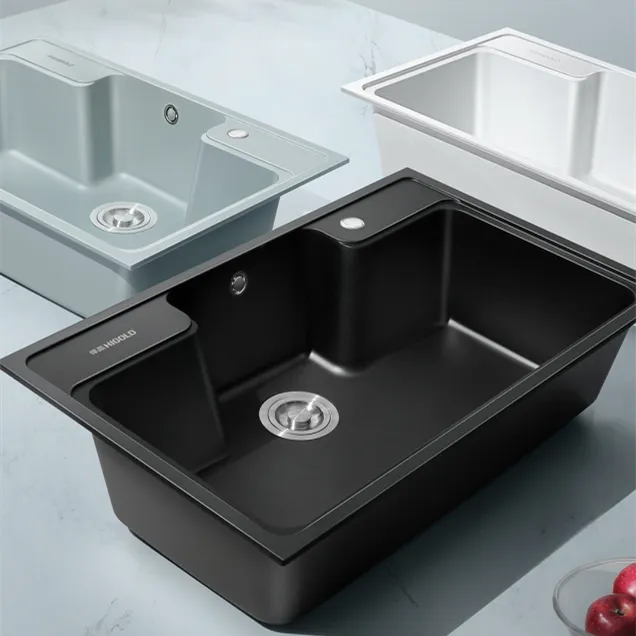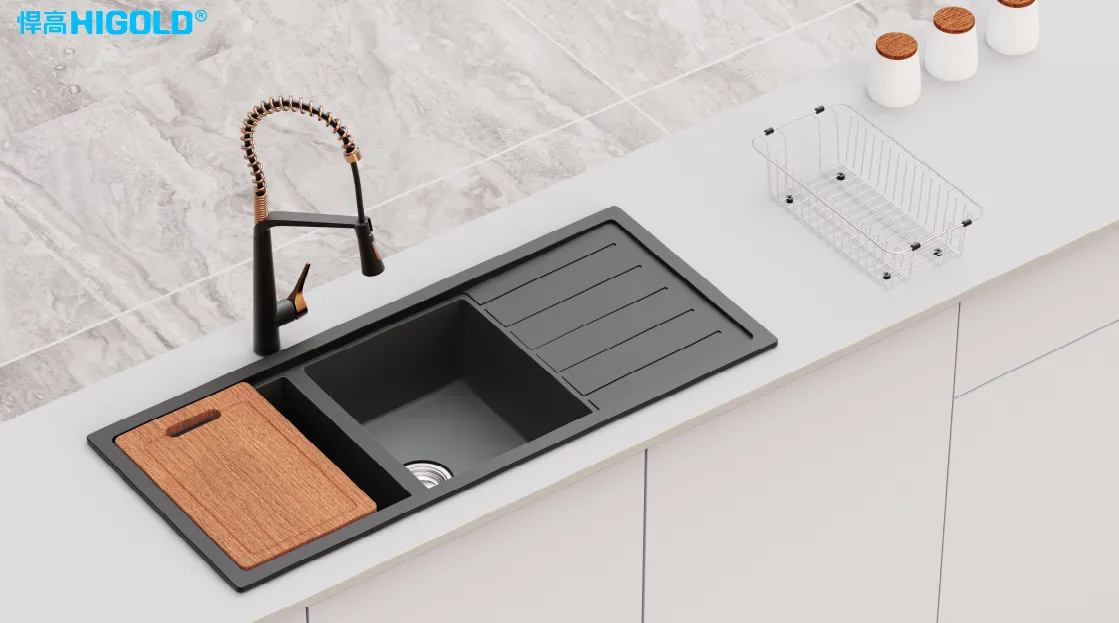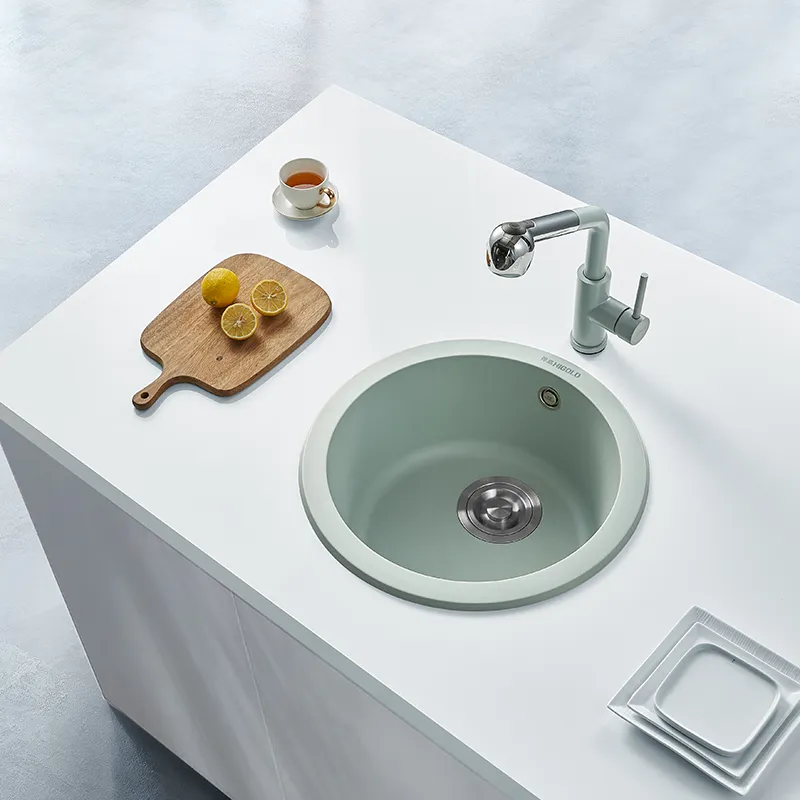The kitchen is one of the busiest areas in every home, and the sink, as an integral part of the kitchen, performs multiple functions, including washing food, dishes, and hands.
Kitchen combination sinks, in particular, have become the preferred sink in many kitchens due to their durability, aesthetics, and practicality. Laundry sinks, on the other hand, are designed specifically for the laundry area and are typically used for washing clothes and other daily household tasks. While they share many functional similarities, they differ significantly in design, materials, and usage.
This article will focus on the two keywords, kitchen combination sinks and laundry sinks, and analyze their differences in function, design, materials, dimensions, installation requirements, and usage scenarios. This will help readers better understand the characteristics of these two types of sinks and make the right choice based on their needs.

What is a kitchen combination sink?
A kitchen combination sink is a sink that combines multiple materials, typically stainless steel with quartz or other composite materials. Combination sinks are widely used in modern kitchens due to their diverse material options and superior performance. Kitchen combination sinks are not only extremely durable but also aesthetically pleasing, meeting the demands of frequent and complex kitchen operations.
• Material Composition: The most distinctive feature of kitchen combination sinks is their use of composite materials. Common composite sink materials include stainless steel, quartz, ceramic, and some newer composite materials. Composite materials can effectively improve sinks' resistance to scratches, stains, and corrosion, making them more durable and easy to clean during daily use.
• Design and Functionality: Kitchen combination sinks are typically designed to balance practicality and aesthetics. For example, composite quartz sinks offer not only strong scratch resistance but also a smooth surface texture that complements a variety of kitchen styles. Kitchen combination sinks also typically feature multiple slots, facilitating various tasks such as washing vegetables, dishwashing, and cleaning up kitchen debris.
• Size and Installation: Kitchen combination sinks come in a variety of sizes, from single to double bowl designs, allowing users to choose according to their specific needs. They also offer a variety of installation options, with undercounter and overcounter sinks being the most common. Undermount sinks are neater and blend smoothly into the countertop, while abovemount sinks are easier to install and offer a unique visual appeal.
• Durability and Maintenance: Composite sinks, particularly quartz sinks, are highly durable, offering excellent resistance to heat, stains, and scratches. However, maintenance methods vary depending on the material used. Composite sinks generally require regular cleaning and avoid using harsh cleaning tools to maintain their smooth and beautiful surface.

What is a laundry sink?
A laundry sink is a sink designed specifically for laundry areas. Its primary function is to help users wash clothes, remove stains, and perform other daily household tasks. Laundry sinks are typically simple in design, highly functional, and made of durable ceramic, stainless steel, or plastic. Laundry sinks are becoming increasingly popular in modern homes, especially those with separate laundry areas.
• Material Selection: Common materials for laundry sinks include ceramic, stainless steel, and plastic. Ceramic sinks are wear-resistant, stain-resistant, and easy to clean, making them suitable for daily use. Stainless steel laundry sinks are popular for their strong corrosion resistance and resistance to deformation. Plastic laundry sinks are generally less expensive but offer less impact resistance, making them suitable for families on a budget.
• Design and Function: Laundry sinks are typically simple in design, often featuring a large, single bowl designed for holding dirty clothes, washed clothes, or mops. Some high-end laundry sinks also feature additional features such as overflows and drains, and some even have adjustable faucets for convenient water control. Laundry sinks lack the multiple compartments of a kitchen combination sink, so their function is more focused on washing clothes and household items.
• Size and Installation: Laundry sinks are generally larger to accommodate larger loads of laundry. Common laundry sink dimensions range from 30-45 cm in depth and 60-80 cm in width, accommodating larger loads. Laundry sinks are generally simple to install, and many can be installed directly next to a washing machine, making it easy to connect the sink to the washing machine.
• Durability and Maintenance: Laundry sinks are typically constructed of durable materials and offer greater durability. Compared to kitchen combination sinks, laundry sinks generally don't require a high gloss finish, so daily maintenance requirements are relatively low. Users only need to clean the sink regularly and keep the drain clear.
What are the differences between kitchen combination sinks and laundry sinks?
After a detailed introduction to kitchen combination sinks and laundry sinks, we can identify the following differences:
1. Differences in Purpose
• Kitchen combination sinks: Primarily used for washing food, dishes, fruits, and vegetables, among other kitchen tasks. They offer a wide range of functions and designs.
• Laundry sinks: Designed specifically for washing clothes, they have a single function and are primarily used for washing clothes and household cleaning tools.
2. Design Differences
• Kitchen combination sinks: Typically feature a more sophisticated design, pursuing a modern, minimalist, and aesthetically pleasing appearance. Combination sinks offer a wider variety of slot designs, often featuring multiple slots to accommodate different operating requirements.
• Laundry sinks: These have a simpler design and focus on practicality. They typically feature a single bowl with a larger bowl for convenient laundry.
3. Size Differences
• Kitchen combination sinks: Available in a variety of sizes, including single and double bowls, to suit different kitchen space requirements.
• Laundry sinks: These are typically larger and designed to accommodate more laundry and cleaning supplies.
4. Installation Locations
• Kitchen combination sinks: These are installed on the kitchen countertop, typically flush with or recessed into the countertop.
• Laundry sinks: These are installed in the laundry area and are typically used in conjunction with a washing machine.
5. Material Options
• Kitchen combination sinks: These are made of higher-end materials, such as stainless steel, composite quartz, and ceramic, offering a wider range of material options.
• Laundry sinks: These have simpler materials, such as ceramic, stainless steel, and plastic, emphasizing durability and practicality.
6. Functionality Differences
• Kitchen combination sinks: These offer a wider range of functions. Besides washing vegetables and dishes, they can also be used for food preparation and cleaning kitchen utensils.
• Laundry sink: Primarily used for laundry, it has a relatively simple function and generally lacks a multi-sink design.

Kitchen combination sink Vs. laundry sink selection recommendations
When choosing between a kitchen combination sink and a laundry sink, users should base their decision on their needs, home layout, and budget.
If you're renovating your kitchen and have high requirements for the sink's appearance, functionality, and durability, a kitchen combination sink is undoubtedly the better choice. Not only can it meet various kitchen needs, but its elegant appearance and durable materials can also enhance the overall quality of the kitchen.
If your home has a dedicated laundry area or you frequently need to wash dirty clothes and tools, a laundry sink is a more practical choice. Its simple design and large capacity are sufficient for laundry and other household cleaning needs.
Does Higold supply kitchen sinks with accessories?
Yes, Higold offers complete kitchen sink kits, which may include strainers, cutting boards, drain baskets, and matched faucets. Selling as a full set helps wholesalers and retailers maximize profit margins while offering end customers a convenient buying experience. Custom kits can be developed for brands that want to differentiate their offerings in the market.


